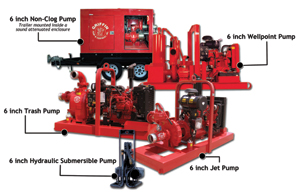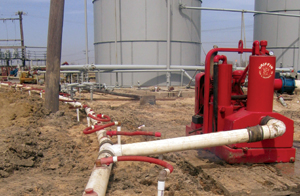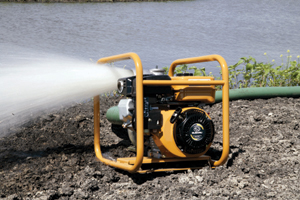Which Pump Is Right for Me?

When determining which pump to us for an application, all pumps are not created equal.
 You have to take a number of factors into account. Among them are flow requirements, head conditions and suction requirements. One of the most popular pump types and sizes — the 6-in. dewatering pumps — is typically capable of pumping in excess of 1,400 gpm, but the success of your project is going to be determined mainly with your pump choice. If you have a specific need, say sumping a lake, wellpointing a construction excavation or sewage bypass pumping, then selecting the right pump will make the project a successful one. Select the wrong pump and the project will face additional challenges.
You have to take a number of factors into account. Among them are flow requirements, head conditions and suction requirements. One of the most popular pump types and sizes — the 6-in. dewatering pumps — is typically capable of pumping in excess of 1,400 gpm, but the success of your project is going to be determined mainly with your pump choice. If you have a specific need, say sumping a lake, wellpointing a construction excavation or sewage bypass pumping, then selecting the right pump will make the project a successful one. Select the wrong pump and the project will face additional challenges.
As an example, a typical person may ask for a diesel driven 6-in. pump capable of pumping 1,400 gpm. For that task, there are a multitude of pumps that meet this requirement, but just because it’s a 6-in. pump doesn’t mean it’s equal in performance to all 6-in. pumps. Even if the application detail was more specific and stated 1,000 gpm at 150 ft head, it’s still not enough information to completely determine which pump is proper for the application.
To make things more complicated, if an end suction centrifugal pump is rented from a generic rental company, and the application is a sewage bypass, the user may encounter a sewage spill because a typical end suction centrifugal pump is not meant to pump sewage. A more appropriate pump would be a diesel-driven trash pump or non-clog pump that is designed to handle sewage and solids.
Other items that must also be considered are the size of the suction and discharge lines, pressure ratings of the lines, valves required and a host of other factors that are generally overlooked, unless there is past experience. In highly critical projects, it is better to contact specialty contractors who typically use and are more familiar with all types of pumps in the everyday field operations.
When selecting the right pump, don’t go to the nearest salesperson and tell them you need a 6-in. pump. Tell him or her what you need the pump to accomplish. A salesperson may give you what he or she has in stock or on the shelf, but a pump and dewatering professional will evaluate your application and give you the right tool. This is only attained from many years of field experience and availability of a large inventory. Let’s take a look at some of the most common 6-in. pumps and where they fit on the jobsite.
Details on Dewatering Pumps
The Wellpoint Pump
A wellpoint pump is designed to pump clean water and effluent for a wellpoint dewatering system and lowers the groundwater table to drain construction excavations. It has the highest air handling capacities on the market and can pump water, while removing large quantities of air without shutting the pump down. A typical 6-in. wellpoint pump is capable of pumping 1,500 gpm with head pressures of 100 ft or more. The water being pumped by a wellpoint pump must be relatively clean. Well suited for: Wellpoint dewatering and sock dewatering.
The Trash Pump
A trash pump is designed to pump clean or dirty and trash laden effluent, and most models will pass 3-in. diameter solids without becoming clogged. These pumps can handle clean, muddy, mucky or trash laden water and incorporate an open impeller and wear plate. A 6-in. trash pump is capable of pumping 1,500 gpm with 125 ft of head. Trash pumps are widely used because of their reliability and versatility. Well suited for: Flood drainage, sewage bypass, pumping polluted wastewater and pumping settled sludge.
The High-Pressure Jet Pump
A high-pressure jet pump is designed to be used as a fire pump to jet casings or wellpoints without drilling or digging to pressure agricultural irrigation systems, as well as in mining and quarry applications where high head capacity is required. Jet pumps are powerful pumps capable of satisfying requirements for high-head capabilities. A typical 6-in. jet pump is capable of pumping thousands of gallons per minute of clean water with several hundred feet of head or more. Non-jet pumps aren’t designed to handle much more than a 100-ft head. As anyone in the mining industry knows, sometimes you can pump water up near 100 ft and still be a long way from the discharge point. A high-pressure jet pump may be capable of achieving discharge heads over 500 ft. You won’t find another pump type that’s better at pushing water that far uphill. Well suited for: Quarries and mining, jetting wellpoints, jetting casings, pipe cleaning, pipe testing, water blasting and marine construction.
The Hydraulic Submersible Pump

The Non-Clog Pump
The non-clog pump offers the best of the pump world by being able to fill multiple roles such as wellpoint pump in wellpoint excavation dewatering, sewage bypass pumping, sumping, flood control applications or other applications that require the pumping of trash-laden effluent. Its non-clog impeller is capable of handling stringy materials and solids up to 3-in. in diameter and large clean out ports offer hassle-free removal of large debris without removing the suction pipe or hose. Well suited for: Wellpoints, flood control, sewer bypass and sumping.
While understanding the different varieties of 6-in. pumps is important, experience of how this equipment works in the field cannot be taught. This pump primer is a good jumping off point, but it’s still the best idea to consult a professional before selecting a pump for your pumping application.
Terry Aylward is the Marketing Manager for Griffin Pump and Equipment, based in Houston.
Top Pump Questions
Griffin Answers the Pump FAQ
Q: I need a pump to handle water laden with trash, sludge or other debris?
A: The 6-in. jet pump and the 6-in. wellpoint pump will clog from debris and stop working and will also cause wear and greatly reduce performance. The 6-in. trash pump, 6-in. non-clog pump or 6-in. hydraulic submersible pumps are the pumps you’ll likely need.
Q: I need a pump with over 300 ft of head?
A: The 6-in. trash pump, 6-in. hydraulic submersible pump, 6-in. non-clog pump and 6-in. wellpoint pump will fail to push the water that high. The 6-in. high-pressure jet pump would be the ticket.
Q: I need a pump that can remove large quantities of air along with the water?
A: The air may cause both the 6-in. trash pump and 6-in. jet pump to stop pumping. The high air-handling capacity of the wellpoint pump or non-clog pump makes both good candidates for this application.
Q: I need a pump to pump out a lake, where the final depth of the lake will be 50 ft. Which pump should I use?
A: While aboveground pumps can be used initially, the suction limitation of all aboveground pumps is approximately 28 ft. The pump would have to be to moved down as the lake emptied. A better choice would be a hydraulic submersible pump as it could be set at the bottom without the need to relocate.
Q: I have a sewer bypass with a long suction line and need the pump to prime with minimal priming time. There is no space for submersible pumps, so I have to use an aboveground pump. What pump should I use to minimize the priming time, as the pumping reaction time is limited and we cannot have a sewage spill?
A: Use a non-clog pump or trash pump with a vacuum unit as the priming device. Typically, all dry priming pumps, which are pumps that do not need water in the pump volute for priming, use a compressor or venturi priming device and diaphragm priming device or vacuum unit. The vacuum unit is the fastest prime due to its air handling capacity.
Q: Why is there such a price difference between pumps? After all, aren’t all pumps basically the same?
A: There is a vast difference between pumps. While the intake and outlet of the pumps may appear the same, flow capacity and head characteristics can vary greatly between manufacturers and models. These, along with the construction materials and accessories, make the difference between an adequate pump and a well-built pump.
All Pumps Considered
By Pam Meyer

Furthermore, be sure to compare the quality between pumps. While it may be tempting to save money and skimp on features, having a higher quality pump that withstands time and abuse will pay for itself in the long run. Because the engine is the driving force behind the pump, it is important for it to be high quality and long lasting. Additionally, the pump housing, impeller and volute are essential to superior operation, so be sure they are well made and not plastic. Some manufacturers equip trash pumps with a wear plate, which absorbs the impact of sticks, stones and other large debris before they enter the impeller. This is a valuable feature that can ensure a longer life for the pump, while reducing maintenance requirements. Lower quality pumps often don’t have frames. Choose a pump with a quality frame to protect the pump, engine and all components.
Finally, check the maintenance requirements of each pump. Regardless of how well built the pump is and how well suited it is for the job, a pump that is not properly maintained will likely cause work interruptions and result in the need for expensive repairs. Select a pump that is easy to maintain and requires only minimal professional attention. Be sure to follow through with maintenance to help prolong the life of the pump.
With so many pumps available, it can be difficult to know if you are using the correct one. Improper selection may result in unsatisfactory performance of the pump, not to mention possible damage to the machine’s components. Having knowledge of each type of pump and more importantly, what is in the water being pumped, will ensure the best selection is made for the job at hand.

Comments are closed here.